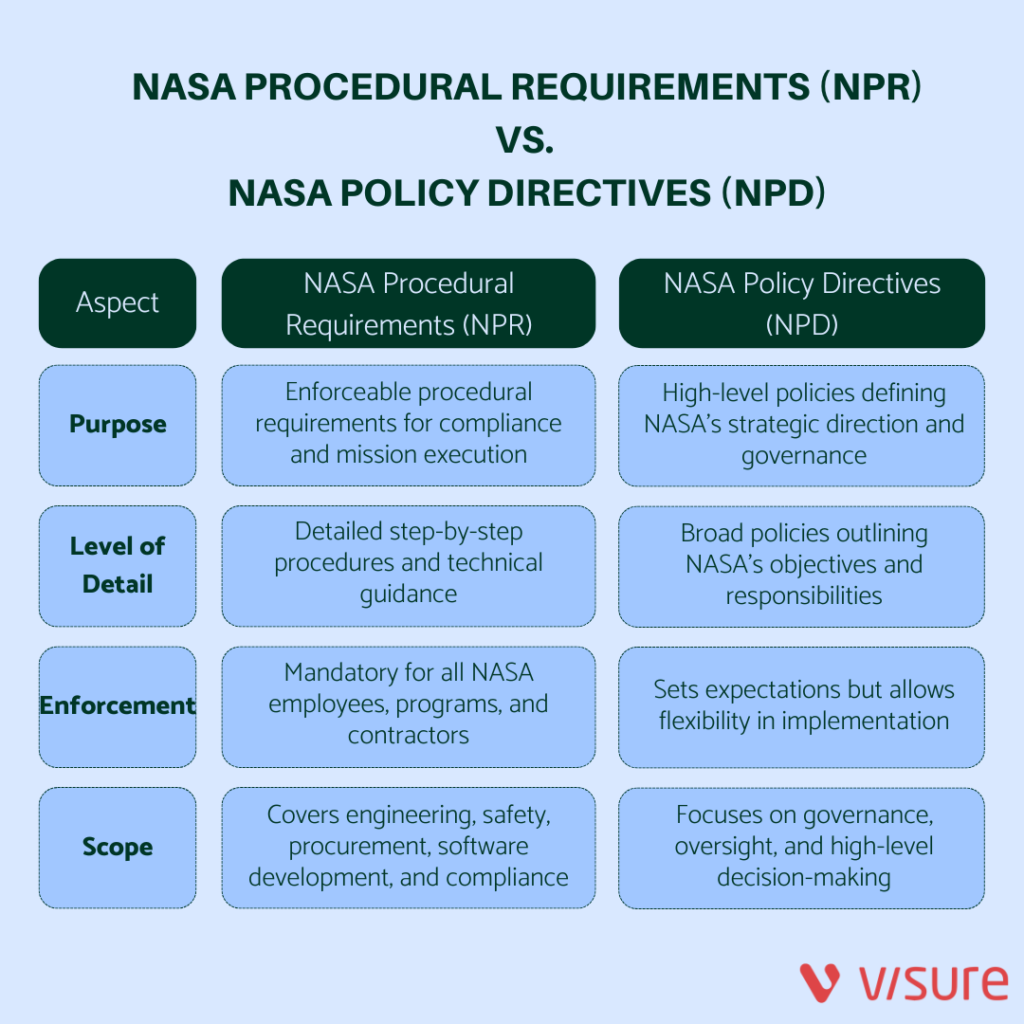Introduction
NASA’s ambitious space missions demand strict regulatory frameworks to ensure safety, mission assurance, and compliance. At the core of these regulations, like NASA NPR, is a structured set of policies that govern NASA’s engineering standards, compliance guidelines, and process documentation.
Understanding NPR is crucial for aerospace professionals, contractors, and organizations working on NASA-funded projects. These procedural requirements help maintain standardized processes, regulatory compliance, and technical excellence, ensuring every mission aligns with safety and mission assurance protocols.
By the end, you’ll have a comprehensive understanding of NASA NPR and how to effectively comply with these essential requirements.
What Are NASA Procedural Requirements (NPR)?
NASA Procedural Requirements (NPR) are a set of detailed, enforceable guidelines that establish standardized processes for managing safety, mission assurance, engineering, and regulatory compliance across all programs and projects. These requirements serve as an internal regulatory framework, ensuring that all activities align with safety, technical, and operational standards.
The primary role of NPRs in agency-wide policy enforcement includes:
- Providing structured procedures for project execution, safety, and risk management.
- Ensuring compliance with federal and NASA’s specific regulations.
- Standardizing engineering, procurement, and operational processes across all departments and contractors.
- Facilitating mission success through rigorous NASA’s compliance requirements and procedural oversight.
NASA Procedural Requirements (NPR) vs. NASA Policy Directives (NPD)
While both NPRs and NPDs govern NASA’s internal operations, they serve distinct roles:

PDs define what needs to be done, while NPRs provide the “how-to” for compliance and execution in line with the standards and policies.
How NPR Supports NASA Standards and Policies for Safety and Mission Success
NASA’s safety and mission assurance depend on strict process documentation and regulatory compliance. NPRs play a crucial role in supporting the policies by:
- Ensuring rigorous engineering standards: NPRs guide systems engineering, software development, and risk assessment, aligning with NASA technical standards to guarantee mission reliability.
- Establishing safety protocols: NPRs enforce safety and mission assurance standards, minimizing risks in spacecraft design, launch operations, and mission execution.
- Providing consistency across projects: By standardizing processes, NPRs help contractors and teams follow uniform procedures, ensuring seamless collaboration and compliance.
- Improving accountability and oversight: NPRs facilitate audits and assessments, ensuring adherence to the compliance guidelines and reducing operational risks.
By strictly following NASA’s Procedural Requirements, organizations can ensure regulatory compliance, mission success, and adherence to NASA’s engineering and safety policies.
Key Elements of NASA Procedural Requirements Documentation
Structure and Format of NASA Process Documentation
NASA Procedural Requirements (NPR) follow a structured, standardized format to ensure clarity, consistency, and enforceability across all projects. The process documentation typically consists of:
- Cover Page & Identification Information – Includes the NPR number, title, approval authority, and effective date.
- Table of Contents – Provides a quick reference to different sections.
- Purpose & Scope – Defines the objective of the NPR and its applicability across all programs.
- Roles & Responsibilities – Outlines the duties of NASA personnel, project managers, and contractors in compliance with the procedural requirements.
- Detailed Procedural Guidelines – Step-by-step instructions covering NASA compliance requirements, engineering processes, safety protocols, and risk management.
- References & Related Documents – Lists applicable NASA Policy Directives (NPDs), technical standards, and federal regulations.
- Appendices & Definitions – Provides additional resources, terminology, and clarifications for technical terms.
This structured approach ensures that all process documentation remains clear, enforceable, and aligned with the agency’s mission assurance objectives.
Important Sections in a Standard NASA NPR Document
A typical NASA Procedural Requirements (NPR) document consists of the following key sections:
1. Introduction & Purpose
- Explains the rationale behind the NPR and how it supports NASA compliance guidelines.
- Defines the scope and applicability of the document.
2. Compliance & Enforcement
- Specifies who must follow the NPR (NASA employees, contractors, or external partners).
- Outlines enforcement mechanisms and penalties for non-compliance.
3. Roles & Responsibilities
- Defines accountability within NASA’s engineering, safety, and mission assurance teams.
- Assigns compliance responsibilities to program managers, engineers, and oversight committees.
4. Detailed Procedures & Technical Requirements
- Provides a step-by-step breakdown of compliance measures.
- Covers areas like systems engineering, safety risk assessment, and software development guidelines.
5. References & Supporting Documents
- Links to related NASA standards and policies, including NASA Policy Directives (NPDs) and federal regulations.
6. Review & Revision Procedures
- Details how NASA engineering standards evolve and how NPRs get updated based on new mission requirements and technological advancements.
How NASA Engineering Standards Integrate with NPR
NASA engineering standards are the foundation for all procedural requirements in NPR documents. They ensure that NASA projects maintain:
- Consistency & Reliability: NPRs align with NASA technical standards to standardize engineering methodologies across projects.
- Mission Safety & Assurance: Compliance with NASA safety and mission assurance protocols is embedded within NPRs to mitigate risks.
- Traceability & Compliance: NPRs reference NASA compliance requirements to ensure regulatory alignment with federal and international aerospace standards.
- Systems Engineering Best Practices: NPRs provide detailed requirements for systems engineering, risk management, and lifecycle processes.
By integrating NASA engineering standards into NPRs, the agency ensures that all missions—from spacecraft design to launch—follow proven, safety-focused, and efficiency-driven processes.
How NASA NPR Impacts Aerospace Projects
Role of NASA Regulatory Framework in Project Approvals
NASA Procedural Requirements (NPR) play a critical role in aerospace project approvals by ensuring that all projects align with NASA’s safety, engineering, and compliance standards. The NASA regulatory framework serves as the foundation for evaluating and approving projects by enforcing:
- Standardized Engineering Practices – Ensuring all designs, systems, and procedures comply with NASA technical standards.
- Safety & Risk Management – Establishing protocols to minimize risks across hardware, software, and operational processes.
- Mission Readiness & Compliance – Verifying that aerospace projects meet NASA’s mission assurance requirements before approval.
- Lifecycle Documentation & Oversight – Mandating strict documentation for traceability, audits, and verification processes.
Before any project receives final approval, it must pass a comprehensive review process, including:
- Preliminary Design Reviews (PDR) and Critical Design Reviews (CDR)
- Risk Assessments and Safety Evaluations
- Verification of NPR Compliance in Engineering & Operations
By adhering to the NASA regulatory framework, projects gain faster approval, reduced risks, and enhanced mission reliability.
Importance of NASA Compliance Guidelines for Contractors and Vendors
For aerospace contractors and vendors, compliance with NASA Procedural Requirements (NPR) is non-negotiable. Failure to meet these NASA compliance guidelines can result in project delays, financial penalties, or contract termination. Key reasons why NPR compliance is essential include:
- Contract Eligibility & Funding – Only vendors meeting NASA compliance requirements are eligible for government contracts.
- Adherence to Quality & Safety Standards – Ensures that all supplied components, software, and engineering processes align with NASA safety and mission assurance protocols.
- Regulatory Compliance & Audit Readiness – Contractors must document and prove compliance with NASA safety standards, procurement policies, and risk management frameworks.
- Technical Consistency & Integration – NPR guidelines establish a uniform framework to streamline collaboration between NASA teams and external contractors.
Contractors working on NASA-funded projects must stay up to date with evolving NASA engineering standards and continuously align their development, testing, and quality assurance processes with NASA’s procedural framework.
Key NASA NPR Documents and Their Significance
NASA Procedural Requirements (NPR) documents govern aerospace projects, safety, engineering, and mission assurance across the agency. These documents ensure compliance, standardization, and regulatory alignment with NASA’s goals. Below are some of the most critical NASA NPRs and their significance.
NPR 7120.5 – NASA Space Flight Program and Project Management Requirements
Significance:
- Defines project lifecycle phases for NASA’s space flight programs.
- Establishes management, risk assessment, and decision-making processes.
- Ensures budgeting, scheduling, and performance compliance for space missions.
NPR 7150.2 – NASA Software Engineering Requirements
Significance:
- Mandates software development, verification, and validation for mission-critical applications.
- Ensures compliance with NASA’s software safety and cybersecurity standards.
- Provides guidelines for software traceability, risk management, and lifecycle processes.
NPR 8705.2 – Human-Rating Requirements for Space Systems
Significance:
- Establishes safety standards for human spaceflight missions.
- Mandates crew safety, redundancy, and failure tolerance in spacecraft design.
- Ensures compliance with NASA safety and mission assurance protocols.
NPR 7123.1 – NASA Systems Engineering Processes and Requirements
Significance:
- Defines the systems engineering framework for all NASA missions.
- Outlines requirements traceability, integration, and verification methodologies.
- Ensures adherence to NASA engineering standards across disciplines.
NPR 8715.3 – NASA General Safety Program Requirements
Significance:
- Governs NASA’s safety and risk management framework.
- Enforces safety measures for mission-critical hardware, software, and operations.
- Establishes safety assurance processes for contractors and vendors.
NPR 7120.8 – Research and Technology Program and Project Management Requirements
Significance:
- Standardizes the technology development lifecycle for NASA projects.
- Guides the transition from research to operational mission deployment.
- Ensures compliance with NASA procedural and technical requirements.
Why These NASA NPRs Matter
These key NPR documents establish compliance frameworks that ensure:
- Mission safety and reliability through strict procedural enforcement.
- Standardized engineering and software processes to maintain technical integrity.
- Contractor and vendor compliance with NASA’s regulatory and safety protocols.
- Efficient project lifecycle management for aerospace development.
By following NASA NPRs, aerospace organizations and contractors can align with NASA’s mission objectives, reduce risks, and ensure spaceflight success.
Conclusion
NASA Procedural Requirements (NPR) serve as the foundation for aerospace project governance, compliance, and mission success. By enforcing engineering best practices, risk management protocols, and safety standards, these structured documents ensure that the projects, contractors, and vendors adhere to the highest levels of quality and reliability.
Understanding key NPR documents—such as NPR 7120.5 for project management, NPR 7150.2 for software engineering, and NPR 8705.2 for human-rating requirements—is essential for organizations working within the aerospace industry. Whether developing mission-critical software, engineering spacecraft, or managing project lifecycles, strict NPR compliance helps reduce risks, streamline approvals, and maintain NASA’s operational excellence.
Managing complex compliance requirements—like NPRs—demands a robust Requirements Management Solution. Visure Requirements ALM Platform helps organizations achieve full traceability, automate compliance checks, and streamline regulatory workflows for NASA projects.
Check out the 14-day free trial at Visure and experience AI-powered requirements management today!
